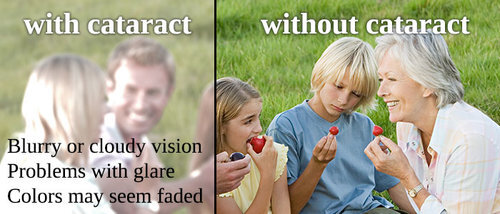Cataracts
A cataract is part of normal aging. Each year, cataract affects millions of people, including more than half of all those older than age 60.
A cataract is a painless clouding of the eye's natural lens. If left untreated, cataracts worsen over time and can interfere with everyday activities such as reading or driving. Night vision is usually affected most. When cataracts are in their early stages, patients will notice that brighter lighting is necessary to see well. As cataracts get worse, however, surgical removal makes a significant difference in the quality of vision.
Risk Factors for Cataracts
The most common cause of cataracts is aging. In addition to aging, the following other factors can increase the risk of developing cataracts:
Diabetes
Smoking
Obesity
Excessive exposure to sunlight
Exposure to upper body radiation
Chronically poor diet
High blood pressure
Previous eye injury or eye surgery
Prolonged use of corticosteroid medications
Diagnosis of Cataracts
Several tests, including the following, are performed to diagnose cataracts:
Visual acuity
Glare testing
Slit-lamp examination
In combination, such tests help determine whether a patient has cataracts, or whether her or his vision problems have some other cause. They also assist in evaluating the degree of visual impairment, and whether surgery is indicated.
Cataract symptoms include the following
Blurred, hazy, or double vision when looking through one eye
Decreased color perception
Sensitivity to bright light and glare at night
Poor night vision
Perception of halos around lights
Frequent changes in corrective-lens prescriptions
Treatment of Cataracts
Early cataracts can sometimes be treated with non-surgical methods, including the following:
New corrective-lens prescriptions
Anti-glare sunglasses
Magnifying lenses
Brighter lighting
If cataracts begin to interfere with reading ability, work, night driving, or other daily activities, cataract surgery may be recommended
Prevention of Cataracts
Although there is no evidence that cataracts can be prevented, their development can sometimes be delayed by the following:
Wearing sunglasses that block ultraviolet rays
Not smoking; not drinking excessively
Eating a healthy diet high in antioxidants
Laser Treatment following Cataract Surgery
YAG LASER (Nd:YAG Laser Capsulotomy)
Overview
The most common complication of cataract surgery is the clouding of the part of the lens covering (capsule) that remains after surgery, called posterior capsule opacification. The vast majority of patients will need a Nd:YAG capsulotomy laser procedure at some point after cataract surgery. It is a simple and painless procedure which will improve your quality of vision, and is generally performed 6 - 24 months after cataract surgery.
What To Expect
Nd:YAG laser posterior capsulotomy is a simple, outpatient procedure. Your doctor will apply a topical anesthetic (eye drop) to numb the eye. A laser is used to produce a small opening in the cloudy membrane that develops behind the lens implant. This allows light to pass through the membrane to the retina at the back of the eye. Prior to discharge, the patients’ eye pressure will be rechecked. This procedure is completely painless.
Why It Is Done
After cataract surgery, some people notice cloudiness (sometimes called an “aftercataract”) after several months or years. In some people, it can become very dense and cause as much or more vision loss as the original cataract. The decision to have this procedure is based on the same criteria as the decision to have the original cataract surgery:
Vision problems are affecting your work or lifestyle.
Glare caused by bright lights is a problem.
You cannot pass a vision test required for a driver's license.
You have double or distorted vision.
The difference in vision between your two eyes is significant.
You have another vision-threatening eye disease.
How Well It Works
Nd:YAG laser posterior capsulotomy reduces glare and improves vision. It lets light pass through the cloudy lens capsule that will very likely develop after cataract surgery.
Risks
The most common complication of Nd:YAG laser posterior capsulotomy is short-term increased pressure inside the eye. You may need to use eye drops for a few days to lower the eye pressure.
Other risks include:
A detachment of the nerve layer at the back of the eye (retinal detachment)
Swelling of the center of the retina (macular edema)
Damage or displacement of the intraocular lens
It should be noted that Dr. Massengale has never had a patient with any signficant complication as a result of YAG laser capsulotomy.
What To Think About
It is common to have a new floater in the eye after this surgery.
Nd:YAG laser posterior capsulotomy is not used to prevent clouding of the back lining of the lens capsule (posterior capsule opacification). Upwards of 90% of cataract surgery patients will eventually need to undergo this simple procedure.


